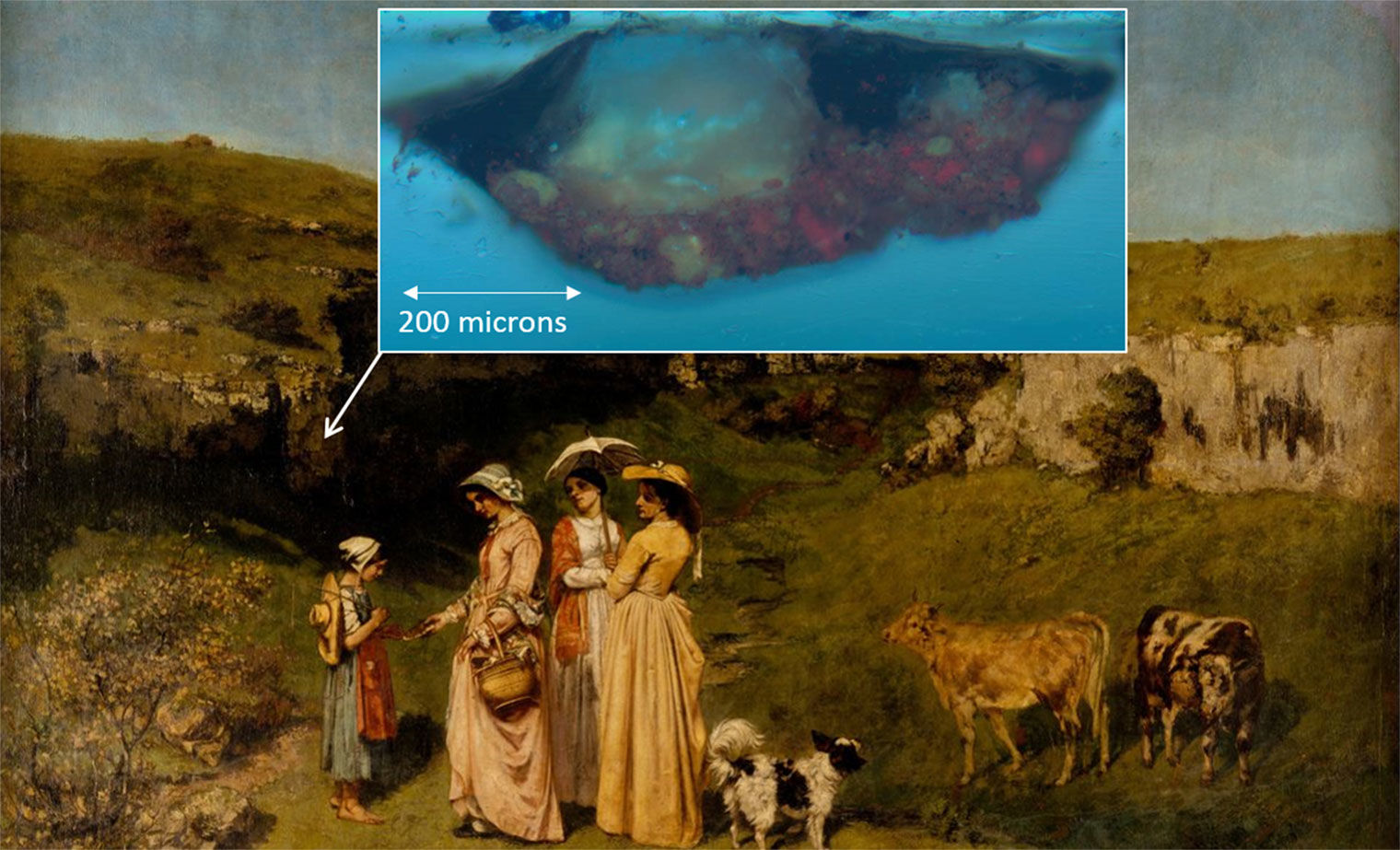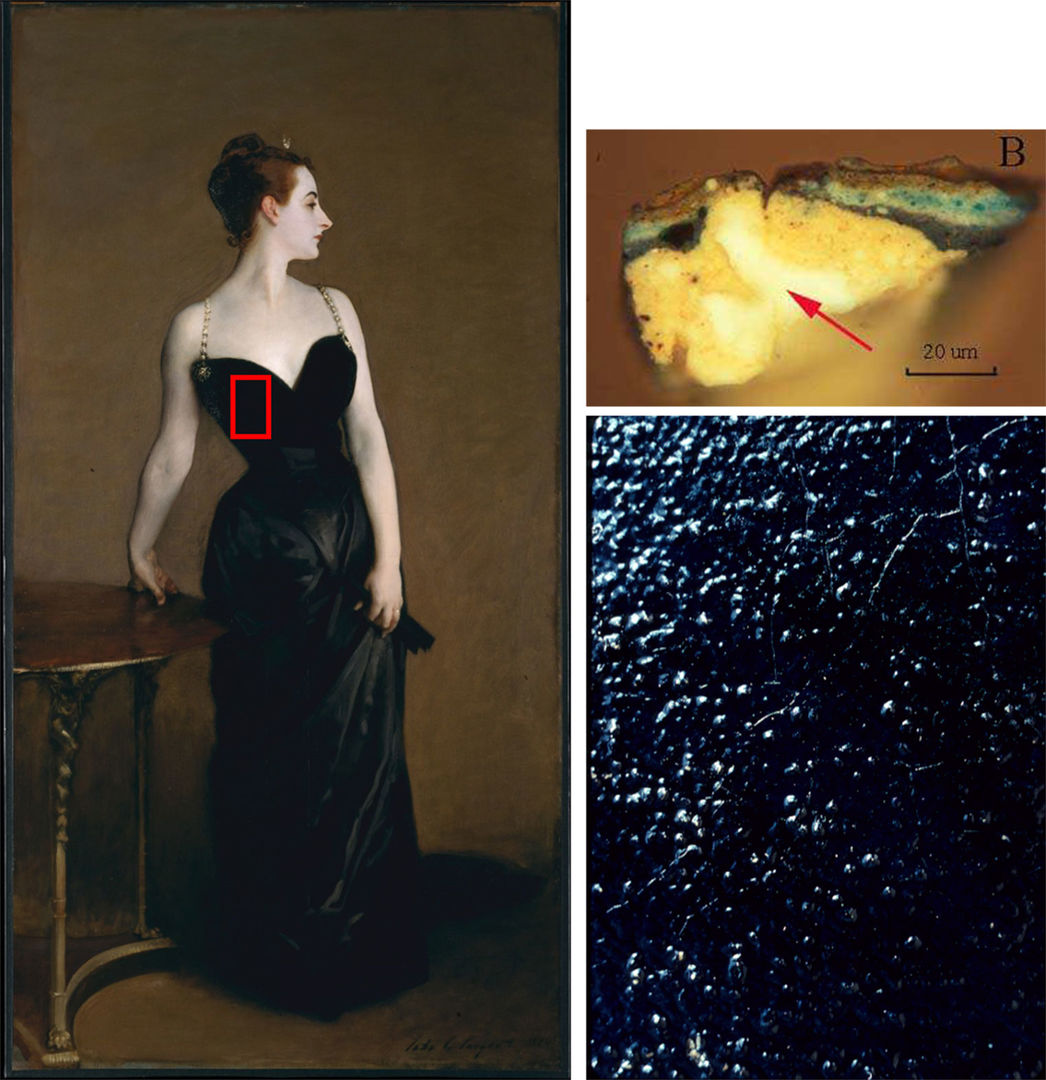Investigation of Heavy-Metal Soap Deterioration in Oil Paintings

A major goal of this project is to determine the causes and mechanisms of a degradation process in traditional oil paintings known as soap formation. Soaps are salts (carboxylates) formed by heavy metals present in the pigments, such as lead and zinc, and fatty acids in the oil-binding medium. This deterioration may compromise the integrity of the artwork in various ways, such as by forming protrusions that break through the paint surface or disfiguring surface crusts or by increasing the transparency of the paint. Despite soap formation having been identified in hundreds of works of art dating from the fifteenth century to the present, the factors trigger the process, what the mechanisms are, and how it can be arrested or prevented are not well known.
We are currently studying the effect that the transport of fatty acids and ions through the paint films, as mediated by water, have on the deterioration process and how this transport is influenced by aging and by environmental conditions such as temperature and relative humidity. To study these factors, we are using a novel approach that combines solid-state nuclear magnetic resonance (NMR) spectroscopy and synchrotron-based x-ray techniques, the latter in collaboration with scientists at Brookhaven National Laboratory.

Left: John Singer Sargent (American, 1856–1925). Madame X (Madame Pierre Gautreau), 1883–84. Oil on canvas, 82 1/8 x 43 1/4 in. (208.6 x 109.9 cm). The Metropolitan Museum of Art, New York, Purchase, Arthur Hoppock Hearn Fund, 1916 (16.53)
Understanding the nature of the chemical processes gives art conservators information on ways to slow, stop, or prevent the deterioration of unique artworks. For example, knowledge of the effect of relative humidity on the reaction allows conservators to assess the best possible environmental conditions to display and store the works, or whether aqueous solutions are safe to use in conservation treatments.
The project is a collaboration with the University of Delaware and is funded by the grants from the Divisions of Chemistry and Materials Science of the National Science Foundation (CHE-1139180, DMR-1608594, CHE-1139192 and DMR-1608366).
Selected Publications
V. Di Tullio, N. Zumbulyadis, S.A. Centeno, J. Catalano, M. Wagner, and C. Dybowski. 'Water Diffusion and Transport in Oil Paints as Studied by Unilateral NMR and 1H High-Resolution MAS-NMR Spectroscopy.' ChemPhysChem, 2020, 21, 113–119.
J. Catalano, V. di Tullio, M. Wagner, N. Zumbulyadis, S.A. Centeno, C. Dybowski. 'Review of the Use of NMR Spectroscopy to Investigate Structure, Reactivity, and Dynamics of Lead Soap Formation in Paintings.' Magnetic Resonance in Chemistry. 2020.
J. Catalano, A. Murphy, Y. Yao, N. Zumbulyadis, S. A. Centeno, C. Dybowski. "Understanding the Dynamics and Structure of Lead Soaps in Oil Paintings using Multinuclear NMR." In F. Casadio, K. Keune, P. Noble, A. van Loon, E. Hendriks, S. Centeno and G. Osmond, eds., Metal Soaps in Art-Conservation & Research, Cultural Heritage Science Series, Springer, 2019.
J. Catalano, A. Murphy, Y. Yao, N. Zumbulyadis, S. A. Centeno, C. Dybowski. "Molecular Dynamics of Palmitic Acid and Lead Palmitate in Cross-linked Linseed Oil Films: Implications from Deuterium Magnetic Resonance for Lead Soap Formation in Traditional Oil Paintings." Solid State Nuclear Magnetic Resonance 89 (2018) 21–26.
Y-C. K. Chen-Wiegart, J. Catalano, G. Williams, A. Murphy, Y. Yao, N. Zumbulyadis, S. A. Centeno, C. Dybowski, J. Thieme. "Elemental and Molecular Segregation in Oil Paintings due to Lead Soap Degradation." Scientific Reports 7 (2017) 11656.
T. Kobayashi, F.A. Perras, A. Murphy, Y. Yao, J. Catalano, S. A. Centeno, C. Dybowski, N. Zumbulyadis and M. Pruski. "DNP-Enhanced Ultrawideline 207Pb Solid-State NMR Spectroscopy: An Application to Cultural Heritage Science." Dalton Transactions 46 (2017) 3535-3540.
J. Catalano, A. Murphy, Y. Yao, G.P.N. Yap, N. Zumbulyadis, S. A. Centeno, C. Dybowski. "Coordination Geometry of Lead Carboxylates-Spectroscopic and Crystallographic Evidence." Journal of the Chemical Society, Dalton Transactions 44 (2015) 2340-2347.
J. Catalano, A. Murphy, Y. Yao, F. Alkan, N. Zumbulyadis, S. A. Centeno, C. Dybowski. "207Pb and 119Sn Solid-State NMR and Relativistic DFT Studies of the Historic Pigment Lead-Tin Yellow Type I and its Reactivity in Oil Paintings." Journal of Physical Chemistry A 118 (2014) 7952-7958.
J. Catalano, Y. Yao, A. Murphy, N. Zumbulyadis, S. A. Centeno, C. Dybowski. "Analysis of Lead Carboxylates and Lead-containing Pigments in Oil Paintings by Solid-State Nuclear Magnetic Resonance." In P. B. Vandiver, W. Li, P. Sciau and C. Maines, Eds., Materials Issues in Art and Archaeology X, MRS Fall Meeting 2013 Symp. Proceedings Vol. 1656, Warrendale, PA, 2014.
J. Catalano, Y. Yao, A. Murphy, N. Zumbulyadis, S. A. Centeno, C. Dybowski. "NMR Spectra and 207Pb Chemical-Shift Tensors of Lead Carboxylates Relevant to Soap Formation in Oil Paintings." Applied Spectroscopy 68:3 (2014) 280–286.
S. A. Centeno, D. Mahon. "The Chemistry of Aging in Oil Paintings: Metal Soaps and Visual Changes." The Metropolitan Museum of Art Bulletin, Summer 2009, The Metropolitan Museum of Art, New York, 12–19.